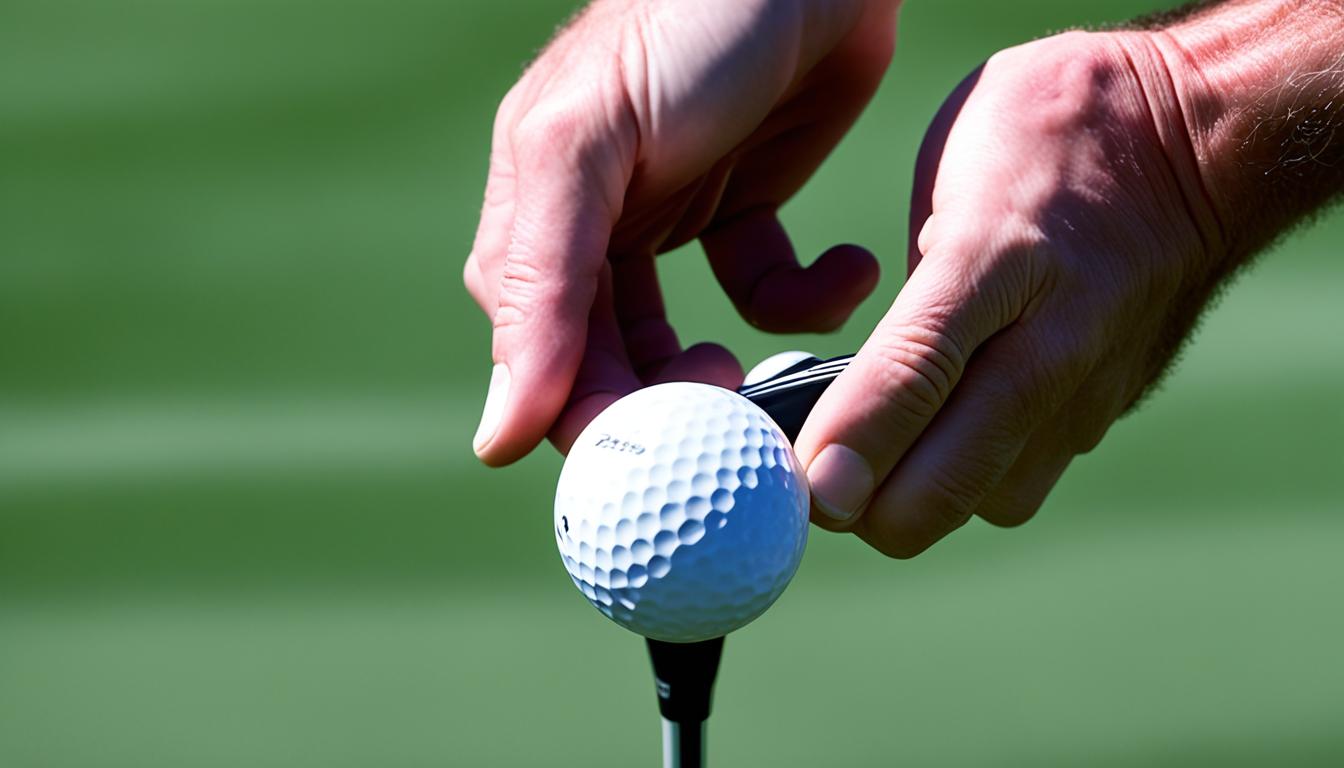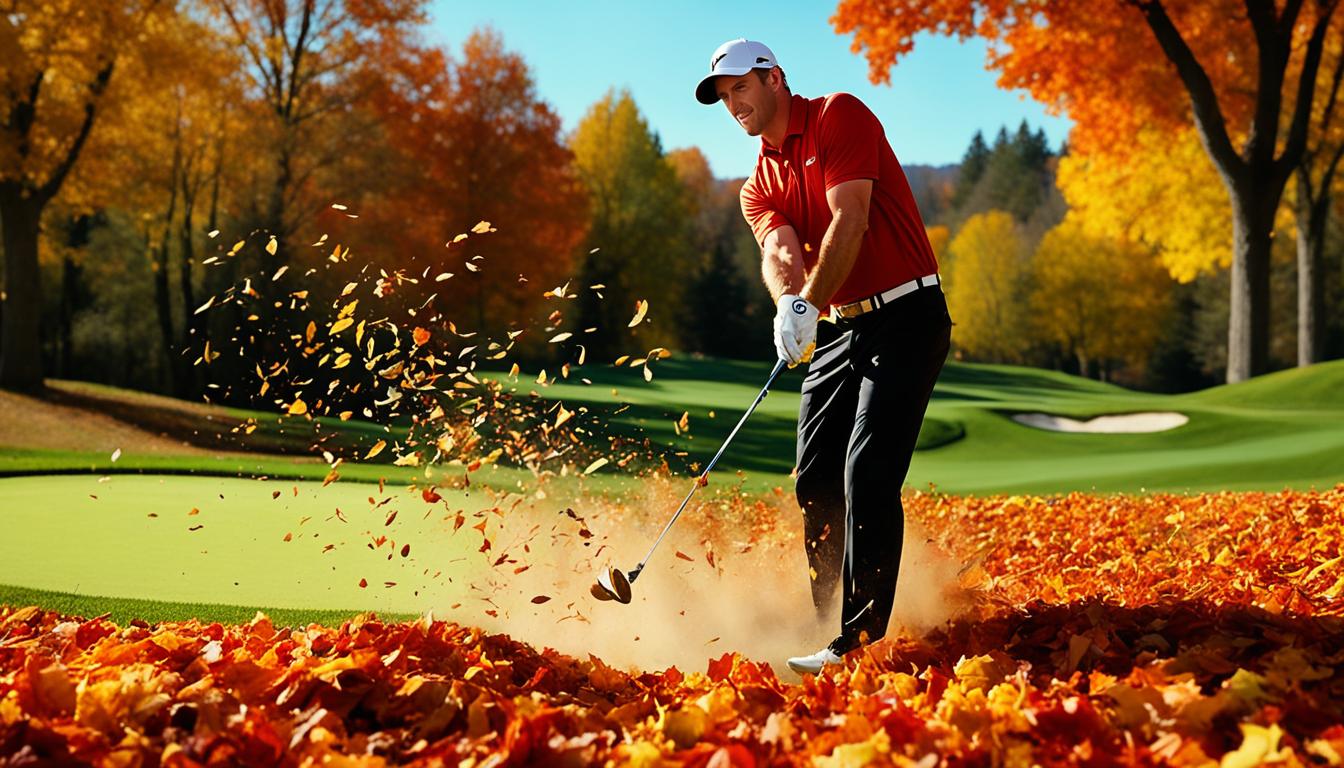When it comes to golf, we know that the tiniest details can make a world of difference in your performance. One such detail that often goes unnoticed but holds tremendous importance is the golf club grip. Properly gripping the club can significantly impact your shot accuracy, making it a crucial aspect of the game that should not be ignored.
A good golf club grip provides stability, control, and power throughout your swing. It allows you to maintain a consistent clubface position, leading to improved accuracy and distance. On the other hand, an improper grip can result in errors and inconsistencies, affecting the trajectory and outcome of your shots.
Key Takeaways:
- A proper golf club grip is essential for shot accuracy in golf.
- A solid grip offers stability, control, and power during the swing.
- Different grip techniques, such as the overlapping grip, interlocking grip, and 10-finger grip, are available.
- Gripping the club too tightly or too loosely can lead to errors.
- Finding the grip that suits your style and promotes a consistent clubface position is crucial.
The Vital Role of a Proper Grip in Golf
A proper grip serves as the foundation for a successful golf swing. It provides stability, control, and power, resulting in more accurate and potent shots. Gripping the club too tightly can restrict wrist movement and lead to a stiff swing, while a too-loose grip can cause the club to slip.
There are several grip techniques to choose from, with the overlapping grip, interlocking grip, and 10-finger grip being the most common choices for golfers. Each grip offers unique benefits in terms of power, stability, and control.
Overlapping Grip
The overlapping grip, also known as the Vardon grip, involves placing the little finger of the trailing hand (right hand for right-handed golfers) between the index and middle fingers of the lead hand. This grip helps promote a unified movement of the hands during the swing, providing stability and control.
Interlocking Grip
The interlocking grip involves interlocking the little finger of the trailing hand with the index finger of the lead hand. This grip is favored by many professional golfers and offers excellent stability and control due to the connected position of the hands.
10-Finger Grip
The 10-finger grip, also known as the baseball grip, involves holding the club with all ten fingers on the grip. This grip provides increased control and is often preferred by individuals with weaker hands or those transitioning from other sports.
It is important to find the grip that suits your hand size and promotes a fluid and natural swing. Experimenting with different grip techniques and seeking guidance from a golf professional can help determine the most suitable grip for your game.
Grip pressure is another crucial aspect to consider. It should be firm enough to maintain control of the club throughout the swing but not overly tight, as it can hinder the natural flow of the swing. Finding the right balance of grip pressure is key to achieving optimal accuracy and power.
Remember, a proper grip sets the stage for a successful golf swing. It provides the necessary stability, control, and power to deliver accurate shots. So take the time to refine your grip and experience the positive impact it can have on your golf game.
Steering Clear of Common Grip Pitfalls
When it comes to golf, avoiding common grip pitfalls is crucial for improving your game. One common mistake golfers make is adopting a weak grip, where the hands are rotated excessively to the left or right. This misalignment can result in an open or closed clubface at impact, leading to slices or hooks that send the ball off target.
Another blunder to steer clear of is gripping the club too tightly. While it may seem intuitive to hold on tightly for control, this can actually backfire. Gripping the club too tightly triggers tension in the hands and arms, affecting the fluidity of your swing and reducing shot accuracy. Finding the right balance of grip pressure is key to maintaining control without sacrificing the natural flow of your swing.
Slipping grips can pose a challenge, especially in wet or humid conditions. A loose or wet grip can cause the club to slip during the swing, resulting in a loss of control and accuracy. To prevent this, it’s important to keep your grips clean and dry. Consider using grip-enhancing products such as tacky sprays or gloves to improve your hold on the club, even in challenging weather conditions.
To summarize:
- Avoid a weak grip that leads to open or closed clubface positions.
- Find the right balance of grip pressure to prevent tension and promote a fluid swing.
- Maintain a firm grip with clean and dry hands to prevent slipping in wet or humid conditions.
| Grip Pitfalls to Avoid | Impact on Golf Game |
|---|---|
| Weak grip (rotated hands) | Slices or hooks |
| Tight grip | Tension, reduced swing fluidity, and decreased accuracy |
| Slipping grips | Loss of control and accuracy |

If that’s not enough, here’s a quote from Jack Nicklaus:
“Good grip, good golf. Bad grip, bad golf.”
Mastering My Favorite Golf Club Grip
When it comes to finding the best grip for golf clubs, the interlocking grip technique stands out as a recommended choice. Not only does it provide utmost stability, but it also enhances your control over the club, resulting in more accurate shots on the golf course.
The interlocking grip is particularly beneficial for right-handed golfers. To achieve this grip, simply connect your right pinky finger with your left index finger. This connection ensures a secure hold on the club, offering stability throughout your swing.
One key aspect to pay attention to when using the interlocking grip is the V shape formed by your thumb and index finger. To optimize your grip, make sure this V points towards your right shoulder. This positioning promotes a consistent grip and helps maintain a square clubface at impact, further enhancing shot accuracy.
With its ability to provide stability, control, and a reliable swing, it is no wonder that the interlocking grip is a popular choice among many golfers. By mastering this grip technique, you can unlock your full potential on the golf course and elevate your game to new heights.
Notable Advantages of the Interlocking Grip:
| Advantages | Description |
|---|---|
| Stability | Provides a secure hold on the club, reducing the chances of it slipping during the swing. |
| Control | Enables a better feel for the club, allowing for precise adjustments throughout the swing. |
| Consistency | Promotes a repeatable grip, leading to a more consistent swing and shot accuracy. |
Conclusion
The proper grip is a fundamental element in the pursuit of improved shot accuracy and overall performance on the golf course. Whether you are just starting out or have years of experience, dedicating time and effort to mastering your grip technique can make a remarkable difference in your game. By familiarizing yourself with various grip styles, avoiding common grip blunders, and honing your grip technique, you can elevate your golf swing and achieve more precise and powerful shots.
It is essential to understand that there is no one-size-fits-all approach to golf club grip. Experimenting with different grip styles such as the overlapping grip, interlocking grip, and 10-finger grip can help you find the one that suits your hand size and promotes a consistent clubface position. Additionally, maintaining the right grip pressure is crucial – firm enough for control, yet not too tight to impede the fluidity of your swing.
As you strive to improve your shot accuracy, remember that a proper grip lays the foundation for success. So, head out to the course, focus on refining your grip technique, and witness the transformation in your golf game. With dedication and practice, you can enhance your golf swing and experience the thrill of hitting more accurate and powerful shots.
FAQ
Why is a proper grip important in golf?
A proper grip provides stability, control, and power throughout the swing, leading to improved accuracy and distance.
What are the different grip techniques in golf?
The different grip techniques include the overlapping grip, interlocking grip, and 10-finger grip.
What happens if I grip the club too tightly or too loosely?
Gripping the club too tightly can restrict wrist movement and lead to a stiff swing, while gripping it too loosely can cause the club to slip.
How do I choose the best grip for my golf clubs?
It is important to find the grip that suits your style and promotes a consistent clubface position for accurate shots. It may vary depending on your hand size and personal preference.
What are some common grip pitfalls to avoid?
Common grip pitfalls include adopting a weak grip, gripping the club too tightly, and facing slipping grips. These errors can affect shot accuracy and consistency.
Which grip technique is recommended for improving grip stability?
The interlocking grip, where the right pinky finger connects with the left index finger (for right-handed golfers), offers utmost stability and control.



